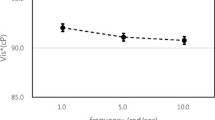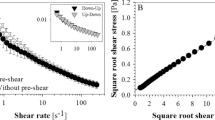Abstract
The viscosity of blood obtained by using a rotational viscometer decreases with the time elapsed from the beginning of measurement until it reaches a constant value determined by the magnitude of shear rate. It is not possible to obtain an initial value of viscosity at time t = 0 that is considered to exhibit an intrinsic property of the fluid by this method. Therefore, we devised a new method by which one can obtain the viscosity of various fluids that are not affected by both the time elapsed from the beginning of measurement and the magnitude of shear rate by considering the balance of the forces acting on a solid spherical particle freely falling in a quiescent viscous fluid. By using the new method, we studied the rheologic behavior of corn syrups, carboxy-methyl cellulose, and human blood; and compared the results with those obtained with a cone-and-plate viscometer. It was found that in the case of corn syrups and washed red cell suspensions in which no red cell aggregate (rouleau) was formed, the viscosity obtained with the two different methods were almost the same. In contrast to this, in the case of the whole blood in which massive aggregates were formed, the viscosity obtained with a falling-ball viscometer was much larger than that obtained with a cone-plate viscometer.





Similar content being viewed by others
References
Asakura T., T. Karino. Flow patterns and spatial distribution of atherosclerotic lesions in human coronary arteries. Circ. Res. 66: 1045–1066, 1990
Chien S. Haemorgeology in disease: pathophysiological significance and therapeutic implications. Clin. Hemorheol. 1: 419–442, 1981
Coull B. M., N. Beamer, P. de Garmo, G. Sexton, F. Nordt, R. Knox, G. V. F. Seaman. Chronic blood hyperviscosity in subjects with acute stroke, transient ischemic attack, and risk factors for stroke. Stroke 22: 162–168, 1991.
Fararoui A., R. C. Kintner. Flow and shape of drops in non-Newtonian fluids. Trans. Soc. Rheol. V: 369–380, 1961
Fisher M., H. J. Meiselman. Hemorheological factors in cerebral ischemia. Stroke 22: 1164–1169, 1991
Ishibashi H., M. Sunamura, T. Karino. Flow patterns and preferred sites of intimal thickening in end-to-end anastomosed vessels. Surgery 117:409–420, 1995
Jan K. M., S. Chien, J. T. Bigger Jr. Observation on blood viscosity changes after acute myocardial infarction. Circulation 51: 1079–1084, 1975
Zarins C. K., D. P. Giddens, B. K. Bharadvaj, V. S. Sottiurai, R. F. Mabon, S. Glsgov. Carotid bifurcation atherosclerosis. Quantitative correlation of plaque localization with flow velocity profiles and wall shear stress. Circ. Res. 53: 502–514, 1983
Acknowledgments
The work was supported in part by The Suzuken Memorial Foundation. The authors thank Drs. Katsuyuki Yamamoto and Makoto Takahashi of the Graduate School of Information Engineering at Hokkaido University in Sapporo, Japan for their help in designing the falling-ball viscometer.
Author information
Authors and Affiliations
Corresponding author
Rights and permissions
About this article
Cite this article
Eguchi, Y., Karino, T. Measurement of Rheologic Property of Blood by a Falling-Ball Blood Viscometer. Ann Biomed Eng 36, 545–553 (2008). https://doi.org/10.1007/s10439-008-9454-7
Received:
Accepted:
Published:
Issue Date:
DOI: https://doi.org/10.1007/s10439-008-9454-7




